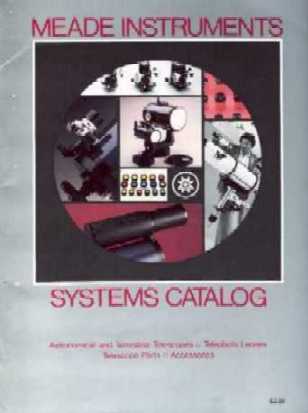
Equipment ads from the 1980's
In many ways, the modern era of amateur astronomical equipment began in the early 1980's.
During these simpler times, the novice looking to upgrade his/her 60 mm department store
refractor had few options. Criterion's RV-6 (and its sometime-mate, the RV-8) was the
reflector of choice. Buyers with more substantial resources went for one of the large
Edmund reflectors. Eventually, if the amateur stuck with it, they wound up with a big
Schmidt Cassegrain from Celestron.
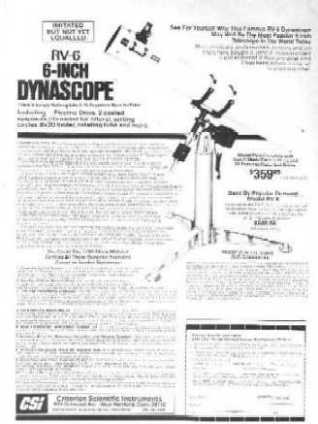
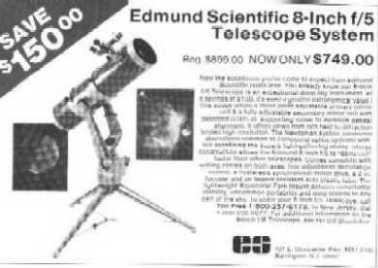 Above: Criterion and Edmund Scientific, two leaders from the 1960's that didn't make it
Celestron's dominance at the high end of the equipment food chain went undisputed for many
years. This was to cause them some problems, some of them quite serious, as the 1980's
progressed. A small company named TeleVue began marketing large eyepieces called "Naglers"
that were viewed at the time in some circles as oddities for rich folks (TeleVue's rapidly
growing customer base was discovering otherwise.) Small telescopes and affordable Plossls
followed a short time later from Al Nagler's fledgling company. Edmund began aggressively
marketing its innovative Astroscan reflector, and the results showed in their numbers at
star parties. Edmund was later to have problems of its own, but the Astroscan has
persevered through the years.
Above: Criterion and Edmund Scientific, two leaders from the 1960's that didn't make it
Celestron's dominance at the high end of the equipment food chain went undisputed for many
years. This was to cause them some problems, some of them quite serious, as the 1980's
progressed. A small company named TeleVue began marketing large eyepieces called "Naglers"
that were viewed at the time in some circles as oddities for rich folks (TeleVue's rapidly
growing customer base was discovering otherwise.) Small telescopes and affordable Plossls
followed a short time later from Al Nagler's fledgling company. Edmund began aggressively
marketing its innovative Astroscan reflector, and the results showed in their numbers at
star parties. Edmund was later to have problems of its own, but the Astroscan has
persevered through the years.
 Above: $200 for an eyepiece? Are they joking?! TeleVue showed that a small, niche
company could thrive on supplying high-quality, albeit expensive products.
The biggest development, however, came from the then-small company that was to forever change
the landscape of amateur astronomy.
Meade Instruments began in the early 1970's as a modest company selling replacement parts for
ATMs. Complete telescopes followed in the latter part of the decade. Meade's growth came
slowly and steadily at first. But then, sometime around 1980, Meade experienced explosive
growth with the introduction of their 2080 series of Schmidt Cassegrain telescopes. Finally,
amateurs had a serious and economical alternative to the Celestron scopes.
The huge inrush of orders to Meade created a depressing backlog situation. I can still
vividly recall that sinking feeling in my chest when the Meade rep told me that delivery on
my reflector would be about 4 months. However, word of the backlog began to feed upon itself,
causing even more people to rush to place their orders before the situation worsened. Sometimes
a serious backlog can be good for a company -- think of the Astro Physics refractors, or the
Harley-Davidson motorcycles of today.
In any case, Celestron acted as if nothing had happened. They continued to do business as
usual, losing countless customers in the process.
In many ways, the advertising strategies of the two companies at the time were quite
revealing -- they were almost diametrically opposed to one another. Meade's ads, done in a
classy black and white, showed studious, somewhat nerdy men, wearing white lab coats and
thick glasses. Meade obviously took their products very seriously, and their literature
reflected this, often approaching the level of fine art.
In contrast, Celestron took a more traditional approach, showing pretty women (some in
dresses and high heels) posing provocatively at the eyepiece. Most of them looked as if
they had never been anywhere near an astronomical telescope before that morning's photo
shoot. Many astronomers I've talked to still resent these ads today. "I'm insulted", is
a typical comment. What they were silently saying was "I'm buying a Meade -- they respect
my hobby."
Above: $200 for an eyepiece? Are they joking?! TeleVue showed that a small, niche
company could thrive on supplying high-quality, albeit expensive products.
The biggest development, however, came from the then-small company that was to forever change
the landscape of amateur astronomy.
Meade Instruments began in the early 1970's as a modest company selling replacement parts for
ATMs. Complete telescopes followed in the latter part of the decade. Meade's growth came
slowly and steadily at first. But then, sometime around 1980, Meade experienced explosive
growth with the introduction of their 2080 series of Schmidt Cassegrain telescopes. Finally,
amateurs had a serious and economical alternative to the Celestron scopes.
The huge inrush of orders to Meade created a depressing backlog situation. I can still
vividly recall that sinking feeling in my chest when the Meade rep told me that delivery on
my reflector would be about 4 months. However, word of the backlog began to feed upon itself,
causing even more people to rush to place their orders before the situation worsened. Sometimes
a serious backlog can be good for a company -- think of the Astro Physics refractors, or the
Harley-Davidson motorcycles of today.
In any case, Celestron acted as if nothing had happened. They continued to do business as
usual, losing countless customers in the process.
In many ways, the advertising strategies of the two companies at the time were quite
revealing -- they were almost diametrically opposed to one another. Meade's ads, done in a
classy black and white, showed studious, somewhat nerdy men, wearing white lab coats and
thick glasses. Meade obviously took their products very seriously, and their literature
reflected this, often approaching the level of fine art.
In contrast, Celestron took a more traditional approach, showing pretty women (some in
dresses and high heels) posing provocatively at the eyepiece. Most of them looked as if
they had never been anywhere near an astronomical telescope before that morning's photo
shoot. Many astronomers I've talked to still resent these ads today. "I'm insulted", is
a typical comment. What they were silently saying was "I'm buying a Meade -- they respect
my hobby."
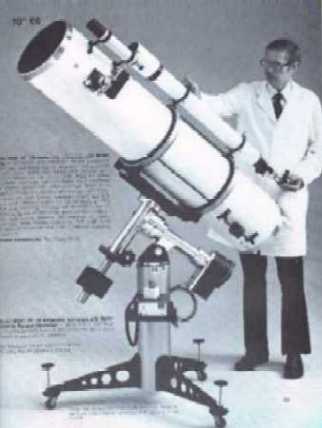
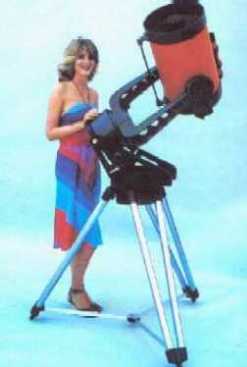 Above: Two ways to skin a cat: Meade and Celestron sending different messages to their customers
Strangely, it took Celestron the better part of a decade before they stopped these ads.
In the meantime, they attempted some really strange ads, such as the one featuring
Leonard Nimoy (below) that had my whole observing group in stitches.
Above: Two ways to skin a cat: Meade and Celestron sending different messages to their customers
Strangely, it took Celestron the better part of a decade before they stopped these ads.
In the meantime, they attempted some really strange ads, such as the one featuring
Leonard Nimoy (below) that had my whole observing group in stitches.
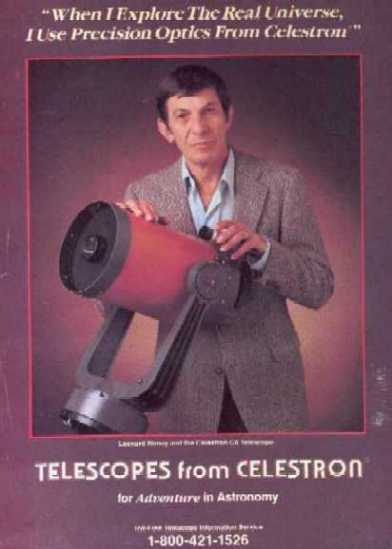 Above: OK, this was a good one!
Eventually, both companies got their marketing and quality acts together (this story could
consume another web page by itself!), with the result being that the amateur is now faced
with a near embarrassment of riches. However, old habits do die hard. The Meade catalogs
are still beautiful works of art. Celestron's marketing is improving, but still has a way
to go. Their 1998 telescope catalog shows two "Celestron girls" -- still no men!
Things have certainly changed in 20 years. A generation ago, it was unthinkable that such
giants as Criterion and Edmund Scientific might not exist. Orion (Telescope and Bino-
cular Center) which started selling parts out of a newsprint flyer, has now become a major
force, importing interesting products from Vixen, Intes, and others. The "rich men's toys"
from TeleVue are everywhere now. Tasco bought Celestron in 1998. And in a strange
twist of fate, Edmund started selling Meade products in its catalogs before they, too,
ran into financial trouble.
Who knows what the next 20 years will bring?
Above: OK, this was a good one!
Eventually, both companies got their marketing and quality acts together (this story could
consume another web page by itself!), with the result being that the amateur is now faced
with a near embarrassment of riches. However, old habits do die hard. The Meade catalogs
are still beautiful works of art. Celestron's marketing is improving, but still has a way
to go. Their 1998 telescope catalog shows two "Celestron girls" -- still no men!
Things have certainly changed in 20 years. A generation ago, it was unthinkable that such
giants as Criterion and Edmund Scientific might not exist. Orion (Telescope and Bino-
cular Center) which started selling parts out of a newsprint flyer, has now become a major
force, importing interesting products from Vixen, Intes, and others. The "rich men's toys"
from TeleVue are everywhere now. Tasco bought Celestron in 1998. And in a strange
twist of fate, Edmund started selling Meade products in its catalogs before they, too,
ran into financial trouble.
Who knows what the next 20 years will bring?
Back to Home Page


 Above: Criterion and Edmund Scientific, two leaders from the 1960's that didn't make it
Celestron's dominance at the high end of the equipment food chain went undisputed for many
years. This was to cause them some problems, some of them quite serious, as the 1980's
progressed. A small company named TeleVue began marketing large eyepieces called "Naglers"
that were viewed at the time in some circles as oddities for rich folks (TeleVue's rapidly
growing customer base was discovering otherwise.) Small telescopes and affordable Plossls
followed a short time later from Al Nagler's fledgling company. Edmund began aggressively
marketing its innovative Astroscan reflector, and the results showed in their numbers at
star parties. Edmund was later to have problems of its own, but the Astroscan has
persevered through the years.
Above: Criterion and Edmund Scientific, two leaders from the 1960's that didn't make it
Celestron's dominance at the high end of the equipment food chain went undisputed for many
years. This was to cause them some problems, some of them quite serious, as the 1980's
progressed. A small company named TeleVue began marketing large eyepieces called "Naglers"
that were viewed at the time in some circles as oddities for rich folks (TeleVue's rapidly
growing customer base was discovering otherwise.) Small telescopes and affordable Plossls
followed a short time later from Al Nagler's fledgling company. Edmund began aggressively
marketing its innovative Astroscan reflector, and the results showed in their numbers at
star parties. Edmund was later to have problems of its own, but the Astroscan has
persevered through the years.


 Above: Two ways to skin a cat: Meade and Celestron sending different messages to their customers
Strangely, it took Celestron the better part of a decade before they stopped these ads.
In the meantime, they attempted some really strange ads, such as the one featuring
Leonard Nimoy (below) that had my whole observing group in stitches.
Above: Two ways to skin a cat: Meade and Celestron sending different messages to their customers
Strangely, it took Celestron the better part of a decade before they stopped these ads.
In the meantime, they attempted some really strange ads, such as the one featuring
Leonard Nimoy (below) that had my whole observing group in stitches.
